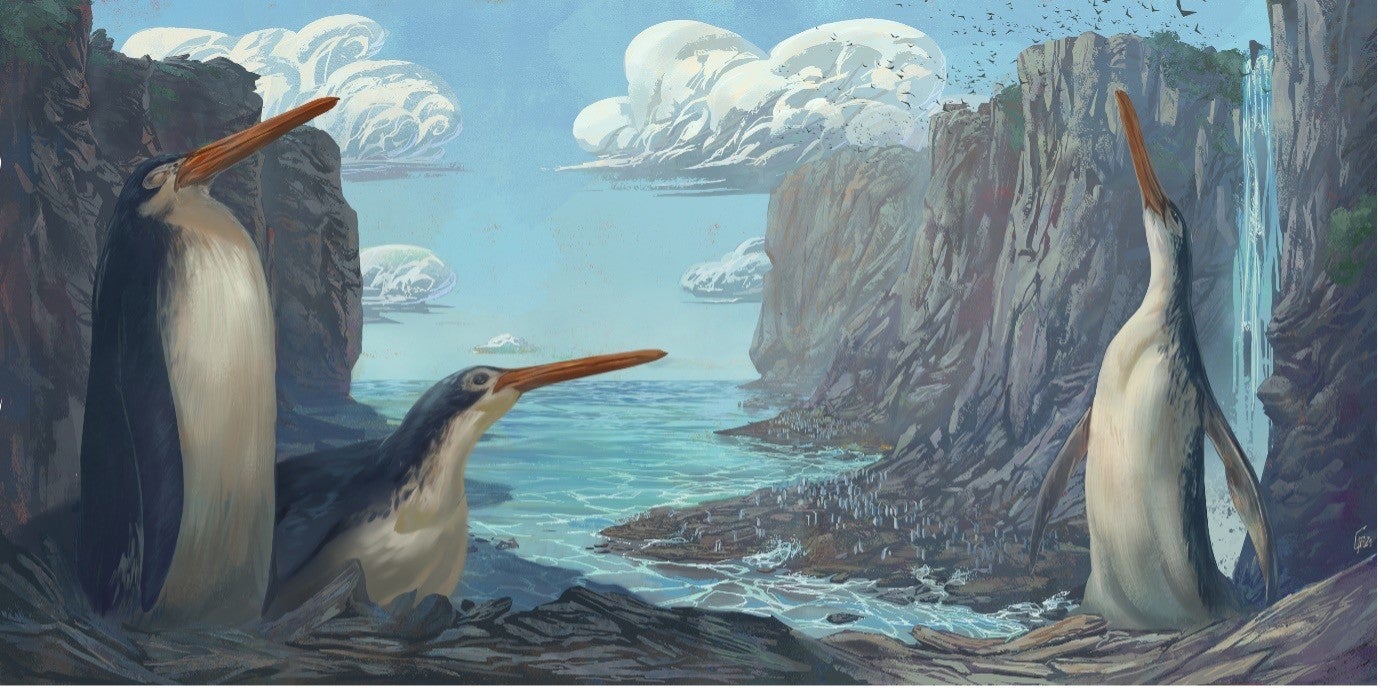‘Incredible’ giant fossilised penguin found by New Zealand schoolchildren is previously unknown species
Thirty million-year-old remains were found during field trip in 2006

The “incredible” fossilised remains of an unusual long-legged giant penguin, first found by schoolchildren in New Zealand, belonged to a previously unknown species, researchers have said.
In 2006, the group of schoolchildren, who were taking part in an organised fossil hunting field trip, discovered the giant set of fossilised penguin bones in Kawhia Harbour, in the Waikato region of New Zealand’s North Island.
The fossils were recovered from the sandstone rock soon afterwards and donated to the Waikato Museum in 2017.
New analysis of the bones, using 3D scanning, enabled the research team, from Massey University in New Zealand and Bruce Museum in Connecticut, to produce a 3D-printed replica of the skeleton, and found the penguin would have stood at around 1.4 metres tall.
In comparison, the tallest penguin species alive today, the emperor, stands at 1.2 metres.
Dr Daniel Thomas, a senior lecturer in Zoology from Massey’s School of Natural and Computational Sciences, said the fossil is between 27.3 and 34.6 million years old and is from a time when much of the Waikato was underwater.
Penguins have a fossil record reaching almost as far back as the age of the dinosaurs, and the most ancient of these penguins have been discovered in New Zealand.
Fossil penguins from Zealandia – the largely submerged continent from which New Zealand now rises above the waves – are mostly known from Otago, in the southeast of the South Island, and Canterbury, in the northeast of the South Island, although important discoveries have recently been made in Taranaki and Waikato, both on the North Island.

“The penguin is similar to the kairuku giant penguins first described in Otago but has much longer legs, which the researchers used to name the penguin waewaeroa – Te reo Māori for “long legs”, Dr Thomas said.
“These longer legs would have made the penguin much taller than other kairuku while it was walking on land, perhaps around 1.4 metres tall, and may have influenced how fast it could swim or how deep it could dive,” he said.
“It’s been a real privilege to contribute to the story of this incredible penguin. We know how important this fossil is to so many people.”
Mike Safey, president of the Hamilton Junior Naturalist Club, which organised the original field trip, said it is something the children involved will remember for the rest of their lives.
“It was a rare privilege for the kids in our club to have the opportunity to discover and rescue this enormous fossil penguin. We always encourage young people to explore and enjoy the great outdoors. There’s plenty of cool stuff out there just waiting to be discovered.”
Steffan Safey, who was there for both the discovery and rescue missions, said: “It’s sort of surreal to know that a discovery we made as kids so many years ago is contributing to academia today. And it’s a new species, even!
“The existence of giant penguins in New Zealand is scarcely known, so it’s really great to know that the community is continuing to study and learn more about them. Clearly the day spent cutting it out of the sandstone was well spent.”
Dr Esther Dale, a plant ecologist who now lives in Switzerland, was also there.
She said: “It’s thrilling enough to be involved with the discovery of such a large and relatively complete fossil, let alone a new species. I’m excited to see what we can learn from it about the evolution of penguins and life in New Zealand.”
Taly Matthews, a long-time member of the Hamilton Junior Naturalist Club, and who works for the Department of Conservation in Taranaki, said: "Finding any fossil is pretty exciting when you think about how much time has passed while this animal remained hidden away, encased in rock. Finding a giant penguin fossil though is on another level. As more giant penguin fossils are discovered we get to fill in more gaps in the story. It’s very exciting."
Dr Thomas added: “The fossil penguin reminds us that we share Zealandia with incredible animal lineages that reach deep into time, and this sharing gives us an important guardianship role. The way the fossil penguin was discovered, by children out discovering nature, reminds us of the importance of encouraging future generations to become kaitiaki [guardians].”
The research is published in the Journal of Vertebrate Paleontology.
Join our commenting forum
Join thought-provoking conversations, follow other Independent readers and see their replies
Comments
Bookmark popover
Removed from bookmarks